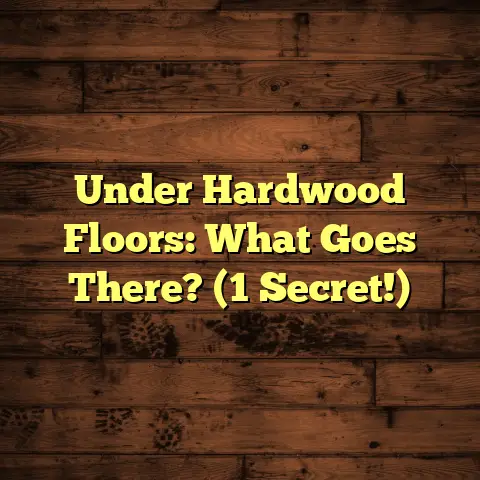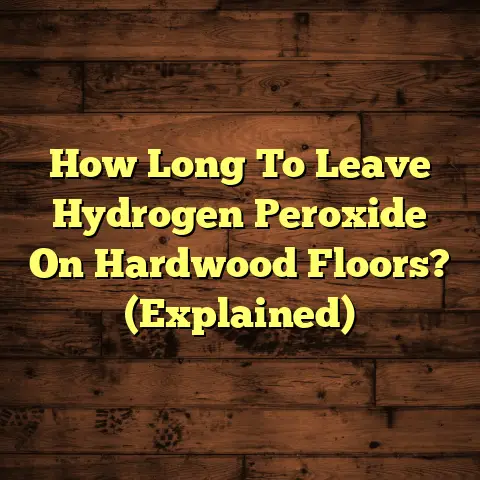Float Solid Wood? (3 Reasons It Might Fail!)
I’m Mike, your friendly neighborhood flooring contractor.
I’ve spent years knee-deep in sawdust and surrounded by beautiful (and sometimes not-so-beautiful) flooring installations.
And let me tell you, I’ve seen it all!
Today, we’re tackling a topic that can be a real head-scratcher: floating solid wood floors.
Now, I know what you might be thinking: “Solid wood? That’s the gold standard! It’s supposed to last forever!”
Well, hold your horses!
While solid wood is incredibly durable, floating it presents some unique challenges.
And ignoring these challenges can lead to some pretty major headaches down the road.
So, let’s dive into those durability myths and uncover the three biggest reasons why your floating solid wood floor might just fail.
Understanding Floating Solid Wood Flooring
First, let’s get our terminology straight.
What exactly is floating solid wood flooring?
Unlike traditional nail-down or glue-down installations, a floating floor isn’t directly attached to the subfloor.
Instead, the planks are connected to each other, usually via a tongue-and-groove system, creating a single, unified surface.
This “floated” floor then rests on top of an underlayment, which provides cushioning and helps to reduce noise.
Think of it like a raft gently resting on the water.
The beauty of this system lies in its ease of installation and its ability to expand and contract with changes in temperature and humidity.
That’s a huge advantage, especially in areas with seasonal shifts.
But, like any flooring option, it’s not without its drawbacks.
When it comes to materials, you’ll typically see hardwoods like oak, maple, and hickory used for floating solid wood floors.
These species offer a good balance of durability, stability, and aesthetics.
However, even within these species, there are variations in grade and cut that can affect performance.
Durability Myths Explored
Okay, let’s bust some myths!
There are a lot of misconceptions out there about solid wood flooring, and it’s time to set the record straight.
Myth 1: “Solid wood flooring is waterproof.”
This is a big one, folks.
And it’s a huge mistake to believe this!
Solid wood and water are not friends.
Think of solid wood as a sponge.
It naturally absorbs and releases moisture from the environment.
In a floating installation, this can be particularly problematic.
Why?
Because excessive moisture can cause the wood to swell, leading to buckling, warping, and even mold growth.
I’ve seen countless floors ruined by leaky appliances, plumbing issues, or even just high humidity levels.
And trust me, it’s not a pretty sight.
So, while solid wood can handle some moisture, it’s definitely not waterproof.
And it’s crucial to protect it from excessive exposure, especially in a floating application.
Myth 2: “Solid wood is scratch-resistant.”
Another common misconception.
While solid wood is durable, it’s not impervious to scratches and dents.
The finish applied to the wood plays a big role in its scratch resistance.
Some finishes are tougher than others.
For example, polyurethane finishes are generally more durable than wax finishes.
But even the toughest finishes can wear down over time, especially in high-traffic areas.
Pets, kids, furniture… they all take their toll!
I’ve seen floors that looked beautiful when they were first installed, but after a few years of wear and tear, they were covered in scratches and dents.
So, don’t expect your solid wood floor to stay pristine forever.
Regular maintenance, like sweeping and mopping, can help to minimize scratches.
And using rugs in high-traffic areas can provide an extra layer of protection.
Myth 3: “All solid wood is equal.”
This is where things get really interesting.
Not all solid wood is created equal!
There are significant differences in wood species, grades, and treatments that can affect durability and performance.
For example, a dense hardwood like hickory will be much more resistant to dents and scratches than a softer wood like pine.
Similarly, the grade of the wood can impact its appearance and stability.
Higher grades of wood will have fewer knots and imperfections, making them less prone to warping and cracking.
And finally, the way the wood is treated can also affect its performance.
Some manufacturers use special drying processes or apply protective coatings to enhance the wood’s durability and resistance to moisture.
So, don’t assume that any solid wood will suffice for a floating installation.
Do your research, and choose a species, grade, and treatment that are appropriate for your specific needs and environment.
Three Reasons Floating Solid Wood Might Fail
Alright, now for the meat of the matter.
Let’s talk about the three biggest reasons why floating solid wood floors fail.
1. Improper Acclimation
This is, without a doubt, the most common mistake I see.
And it’s also one of the easiest to avoid.
Acclimation is the process of allowing the wood flooring to adjust to the temperature and humidity of the installation environment before it’s installed.
Remember how I said solid wood is like a sponge?
Well, it needs time to absorb or release moisture until it reaches equilibrium with its surroundings.
If you skip this step, you’re asking for trouble.
If the wood is too dry when it’s installed, it will absorb moisture from the air and expand.
This can cause the floor to buckle and warp.
On the other hand, if the wood is too wet, it will release moisture and shrink.
This can create unsightly gaps between the planks.
I’ve seen floors that were perfectly installed, only to develop major problems within a few weeks because they weren’t properly acclimated.
The Wood Doctor states that “Wood is hygroscopic, meaning it will absorb and release moisture until it reaches equilibrium with its surroundings.”
So, how long should you acclimate your flooring?
The general rule of thumb is to allow the wood to sit in the installation environment for at least 3-5 days, or even longer, depending on the species and the local climate.
I always recommend checking the manufacturer’s recommendations for specific acclimation guidelines.
And don’t forget to monitor the temperature and humidity levels in the room during acclimation.
Ideally, you want to maintain a consistent temperature between 60-80°F and a humidity level between 30-50%.
Failing to do so can lead to disastrous results.
Case Study: I once worked on a project where a homeowner insisted on installing their solid wood floor immediately after it was delivered.
Despite my warnings, they were impatient and wanted to get the job done quickly.
Within a few weeks, the floor started to buckle and warp in several areas.
The homeowner was furious and blamed the quality of the wood.
But the truth was, the failure was entirely due to improper acclimation.
They ended up having to replace the entire floor, which cost them a lot of time and money.
2. Moisture Issues
We’ve already touched on this, but it’s worth reiterating: moisture is the enemy of floating solid wood floors.
Excessive moisture from below (the subfloor) or above (humidity) can wreak havoc on your investment.
Moisture from below can come from a variety of sources, including leaky pipes, groundwater seepage, or even just a damp concrete slab.
If the subfloor isn’t properly sealed and moisture-proofed, moisture can wick up into the wood flooring, causing it to swell, warp, and even rot.
And moisture from above can be just as damaging.
High humidity levels can cause the wood to absorb moisture from the air, leading to the same problems as moisture from below.
I’ve seen floors ruined by something as simple as forgetting to run a dehumidifier during a humid summer.
Expert Opinion: According to the National Wood Flooring Association (NWFA), “Excessive moisture is the leading cause of flooring failures.”
They recommend testing the moisture content of both the wood flooring and the subfloor before installation.
The NWFA suggests the moisture content of wood flooring should be between 6% and 9% prior to installation. (Source: NWFA Technical Guidelines)
If the moisture content is too high, you’ll need to take steps to dry out the subfloor and/or the wood flooring before proceeding.
This might involve using a dehumidifier, a fan, or even a specialized drying system.
Once the floor is installed, it’s important to maintain a consistent humidity level in the room.
This can be achieved by using a humidifier or dehumidifier, as needed.
And be sure to address any leaks or plumbing issues promptly to prevent moisture from seeping into the subfloor.
3. Subfloor Conditions
Last but not least, let’s talk about the subfloor.
The subfloor is the foundation upon which your floating solid wood floor rests.
And if it’s not in good condition, it can compromise the performance of even the highest-quality flooring.
Common subfloor problems include unevenness, lack of structural integrity, and improper materials.
Unevenness is a major issue because it can cause the floating floor to flex and move excessively.
This can lead to squeaking, cracking, and premature wear.
I’ve seen floors that looked perfectly flat to the naked eye, but when I laid a level on them, I discovered significant dips and bumps.
A good rule of thumb is to ensure that the subfloor is flat to within 3/16″ over a 10-foot span.
If it’s not, you’ll need to level it using a self-leveling compound or by sanding down high spots.
Lack of structural integrity is another common problem.
If the subfloor is weak or damaged, it can’t provide adequate support for the floating floor.
This can lead to the floor feeling spongy or unstable.
I’ve seen subfloors that were riddled with rot, insect damage, or even just loose nails.
In these cases, the subfloor will need to be repaired or replaced before installing the floating floor.
And finally, using improper materials for the subfloor can also cause problems.
For example, using OSB (oriented strand board) instead of plywood can increase the risk of moisture damage.
OSB is more absorbent than plywood, so it’s more likely to swell and warp if it gets wet.
I always recommend using plywood for subfloors, especially in areas that are prone to moisture.
Personal Experience: I once worked on a project where a homeowner had installed a floating solid wood floor over a subfloor made of OSB.
Within a year, the floor started to develop soft spots and buckling in several areas.
Upon closer inspection, I discovered that the OSB had absorbed moisture from a leaky pipe and was starting to rot.
The homeowner ended up having to replace the entire subfloor and flooring, which was a very expensive and time-consuming process.
Conclusion
So, there you have it!
The three biggest reasons why floating solid wood floors fail: improper acclimation, moisture issues, and subfloor conditions.
I hope this article has shed some light on the potential pitfalls of floating solid wood installations.
Remember, while floating solid wood flooring can be a beautiful and functional choice for many homes, it’s essential to understand its limitations and the factors that can lead to failure.
Approach your flooring projects with a comprehensive understanding of both the benefits and potential pitfalls associated with floating solid wood installations.
By taking the time to properly prepare the subfloor, acclimate the wood, and protect it from moisture, you can ensure that your floating solid wood floor will last for years to come.
Happy flooring!





